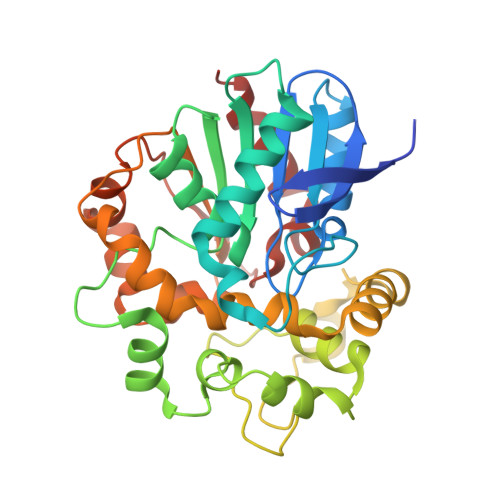Removal of distal protein-water hydrogen bonds in a plant epoxide hydrolase increases catalytic turnover but decreases thermostability
Thomaeus, A., Naworyta, A., Mowbray, S.L., Widersten, M.(2008) Protein Sci 17: 1275-1284
- PubMed: 18515642
- DOI: https://doi.org/10.1110/ps.034173.107
- Primary Citation of Related Structures:
3CXU - PubMed Abstract:
A putative proton wire in potato soluble epoxide hydrolase 1, StEH1, was identified and investigated by means of site-directed mutagenesis, steady-state kinetic measurements, temperature inactivation studies, and X-ray crystallography. The chain of hydrogen bonds includes five water molecules coordinated through backbone carbonyl oxygens of Pro(186), Leu(266), His(269), and the His(153) imidazole. The hydroxyl of Tyr(149) is also an integrated component of the chain, which leads to the hydroxyl of Tyr(154). Available data suggest that Tyr(154) functions as a final proton donor to the anionic alkylenzyme intermediate formed during catalysis. To investigate the role of the putative proton wire, mutants Y149F, H153F, and Y149F/H153F were constructed and purified. The structure of the Y149F mutant was solved by molecular replacement and refined to 2.0 A resolution. Comparison with the structure of wild-type StEH1 revealed only subtle structural differences. The hydroxyl group lost as a result of the mutation was replaced by a water molecule, thus maintaining a functioning hydrogen bond network in the proton wire. All mutants showed decreased catalytic efficiencies with the R,R-enantiomer of trans-stilbene oxide, whereas with the S,S-enantiomer, k (cat)/K (M) was similar or slightly increased compared with the wild-type reactions. k (cat) for the Y149F mutant with either TSO enantiomer was increased; thus the lowered enzyme efficiencies were due to increases in K (M). Thermal inactivation studies revealed that the mutated enzymes were more sensitive to elevated temperatures than the wild-type enzyme. Hence, structural alterations affecting the hydrogen bond chain caused increases in k (cat) but lowered thermostability.
- Department of Biochemistry and Organic Chemistry, Uppsala University, SE-751 23 Uppsala, Sweden.
Organizational Affiliation:

















